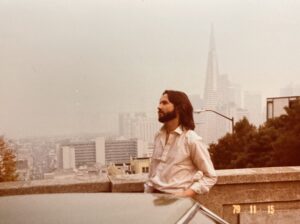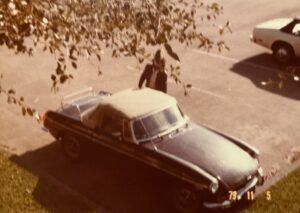On One’s Attraction to Beautiful Models and Minds
(A Very Short Critique of Mainstream Economics)
The fact that our resources (things, money, time) are limited forces us to make choices, often very quickly. We have free will for sure, but we also display ‘bounded rationality’, meaning that our capability to think of reasons for and against doing something depends on the circumstances in which we find ourselves.1 We are ‘affected by social influences’, we ‘misjudge risk’ and ‘have a tendency to short-termism’, and ‘our personality, mood, and emotions drive our choices and decisions’.2
This is quite a radical departure from the ‘rational agent’ posited by the mainstream economics I was taught at the University of California in Davis, by Steven Sheffrin in particular.3 It made (still makes) it hard for me to hold on to traditional consumer models that put maximizing utility at their core.4
‘But it’s only a metaphor’ would be the retort of Steven Buccola, who also attended agricultural economics classes at UC Davis.5 For him, utility is the intuition behind consumer decisions and optimization the analogy to judgment and choice. After urging us to distinguish Hume’s empirical intuition from Kant’s pure intuition, he writes: ‘The decision maker’s a priori pure intuition then – the capacity to synthesize intuitive sense with abstract thought, empirical intuition with concepts, creating an order or pattern – is what I argue utility represents in mainstream economics. […] The synthetic a priori of Immanuel Kant constitutes the center of economic logic and reason’.6
According to Geoffrey Warnock (discussing Kant with Bryan Magee): ‘Kant put forward the claim that, if one thought carefully enough and argued long enough, one could specify what he called the Form of any possible experience […] a body of doctrine […]. I think the fundamental principle of his argument here is that any possible world of experience, any world about which objective statements can be made and (sometimes) known to be true, must necessarily be in certain respects orderly, and predictable’.7
There is something ‘Newtonian’ in Buccola’s grand quest for order and predictability, as he seemingly wants to apply mathematics (and logic) to the entire world of economic experience.8
If he just means that the role of mainstream economics is to offer us templates for ‘what might be if…’, and its main interest lies in showing how far (and maybe why) what we observe on the ground departs from these schemas, then that’s fine with me. (Most wine markets, for instance, appear to be in a permanent state of disequilibrium.)
If not, then his panegyric on the ‘utility’ of mainstream economics fails to convince me. Metaphors may be indispensable to the way scientists think but they have their shelf life and holding too tightly to them can stymie your creativity.9 As Gillian Tett puts it: ‘the neoliberal [i.e. mainstream] economic model was fostered by extreme tunnel vision […]. Anthropologists have been howling for decades that economics is embedded in social relationships and you can’t look at it just in terms of numbers’.10 I wouldn’t go as far as ditching the whole mainstream doctrine, as suggested by Peter Earl, an ‘old’ behavioural economist who argues that even tweaking the neoclassical model to accommodate bounded rationality (as many of his ‘new’ colleagues do) is methodologically flawed: either consumers are deemed to be rational or they aren’t.11
My issue with mainstream economics is abiding and quite specific: there was (still is) no room for product differentiation and related phenomena like ‘appellation/brand loyalty’ and ‘two-way trade’ that are so critical to understanding how wine markets operate. The reason is that one assumes that consumers choose amongst bundles of goods rather than amongst bundles of their attributes (characteristics).12
In the mid-1960s Kelvin Lancaster developed a theory stipulating that consumers ‘regard a product as having multiple characteristics and […] weigh the various combinations of characteristics contained in different [products] in reaching their decisions’.13 In his model consumers (who have different tastes) still maximize their utility, though not via the purchase of the goods themselves but through the acquisition of their various characteristics (attributes), from which they derive benefits.14 That approach to consumer demand was much more akin to what happened in marketing (i.e. quite realistic) but, because it was more difficult to work with mathematically, it was never really taken up by mainstream economists.15
So I’ve adopted a gradually more satisficing,16 Humean approach over time, that blends economic analysis with elements of marketing, psychology and, now, neuroscience. The first economic book ever handed to me whilst still at high school was, after all, a translation of The Mass Consumption Society by George Katona, the precursor of behavioural economics.
May 15th, 2025

References
Baddeley, Michelle (2017) Behavioural Economics – A Very Short Introduction. Oxford: Oxford University Press.
Buccola, Steven (2025) How Economists Think – A Kantian Interpretation of Mainstream Economics. Abingdon: Routledge.
Cartwright, Edward (2024) Behavioral Economics (4th ed.). Abingdon: Routledge.
Cobb, Matthew (2021) The Idea of the Brain – A History. London: Profile Books.
Cook, Mark and Farquharson, Corri (1998) Business Economics – Strategy and Applications. Harlow: Financial Times–Prentice Hall.
Earl, Peter E. (2022) Behavioral Economics – Bringing Together Old, New and Evolutionary Approaches. Cambridge: Cambridge University Press.
Helpman, Elhanan (1981) ‘International Trade in the Presence of Product Differentiation, Economies of Scale and Monopolistic Competition – A Chamberlin-Heckscher-Ohlin Approach’, in Journal of International Economics 11, 305-40.
Kahneman, Daniel and Tversky, Amos (1979). ‘Prospect Theory: An Analysis of Decision under Risk’, in Econometrica, 47(2), 263-91.
Katona, George (1965) Der Massen-Konsum – Eine Psychologie der neuen Käuferschichten. Wien-Düsseldorf: Econ-Verlag.
Krugman, Paul R. (1994) Rethinking International Trade. Cambridge (MA) and London: MIT Press.
Labys, Walter C. (1973) Dynamic Commodity Models: Specification, Estimation, and Simulation. Lexington (MA): Lexington Books.
Laidler, David (1981) Introduction to Microeconomics (2nd ed.). Deddington: Philip Allan Publishers Ltd.
Lancaster, Kelvin J. (1966) ‘A New Approach to Consumer Theory’, in Journal of Political Economy, LXXIV, 132-57.
Magee, Bryan (1987) The Great Philosophers – An Introduction to Western Philosophy. London: BBC Books.
Sheffrin, Steven M. (1983) Rational Expectations. Cambridge: Cambridge University Press.
Thaler, Richard H. (1980) ‘Toward a Positive Theory of Consumer Choice’, in Journal of Economic Behavior and Organization, I(1), 39-60.
Varian, Hal R. (1978) Microeconomic Analysis. New York: W. W. Norton & Co. Inc.
Von Neumann, John and Morgenstern, Oskar (1944) Theory of Games and Economic Behavior. Princeton (NJ): Princeton University Press.

- ‘Bounded rationality is a doctrine stressing man’s limited computational abilities in making decisions.’ (I borrow this loose definition of ‘rationality’ from Geoffrey Warnock (in Magee, 1987, p 184).) It was elaborated by Herbert Simon at Carnegie Mellon in the late 1950s and early 1960s. At the same time, his colleague John F. Muth was developing his own doctrine of ‘rational expectations’ (Sheffrin, 1983, p 1). ↩︎
- Baddeley (2017, p 7). ↩︎
- Steve taught me micro- and macroeconomics. He’s the author of Rational Expectations (1983). His lectures were just brilliant! ↩︎
- Utility is unobservable and doesn’t lend itself to any psychological interpretation (Varian, 1978, pp 81, 92). ↩︎
- Steven Buccola studied philosophy at St. Mary’s College of California in the San Francisco Bay Area (B.A. in 1966), then earned an M.S. and a Ph.D. in agricultural economics from UC Davis, in 1972 and 1976 respectively. His 2025 book How Economists Think – A Kantian Interpretation of Mainstream Economics is the inspiration behind this piece.
I became acquainted with logic and epistemology (Erkenntnistheorie) at high school in Engelberg (Switzerland). At university, my two mentors (Blas Lara and Walter Labys) taught me operations research, statistics and econometrics. Walt’s book Dynamic Commodity Models: Specification, Estimation, and Simulation (1973) made a great impact on me. I earned a doctorate in business economics from the University of Lausanne (once home to Léon Walras and Wilfredo Pareto) and went on to read agricultural economics at UC Davis in 1978 (M.S. in 1980) – at Walt’s suggestion. ↩︎ - Buccola (2025, p 126). He adds ‘[…] Economic thought takes place at two tiers or levels: of reasoning and theory which is cause-and-effect (but only metaphorically so), and of human choice which is aware of its freedom. To be free is to accept or reject the moral call, inseparable from being a person’ (ibid., p 25). ‘Choice and freedom, as choice and freedom, can only be hinted at: in particular in the form of an optimization, a seeming mechanism but only an analogy to judgment and choice.’ […] ‘Freedom, choice, cannot be modeled as freedom or choice because models must always be expressed in causal-sounding language. […] This is why economic models must always have an “as-if” character – expressed as if choices were mechanical though they are not, something that the vast, confused literature on homo economicus will never grasp’ (ibid., p 128), italics are my own. ↩︎
- Magee (1987, pp 177-9). ↩︎
- spanning both classes of a priori synthetics: the ‘forms of sensibility’ and the ‘forms of understanding (or thought)’. Kant ‘had no doubt that Newton had got it absolutely right, and that a physicist’s description of the world as an object of possible experience was essentially correct and could be exhaustive’ (Warnock, in Magee, 1987, p 182). Einstein acknowledged that, had he not read Hume, he wouldn’t have dared to challenge Newton’s mechanics. ↩︎
- ‘We end up limiting what and how we think […] metaphors shape our ideas in ways that are not always helpful.’ Cobb (2021, pp 4, 371-7). ↩︎
- Gillian Tett is a columnist at the Financial Times. She was speaking on the The Ezra Klein Show – a New York Times podcast – on March 14th, 2025 (nytimes.com/podcasts). ↩︎
- Cartwright (2024, pp 118-39), for instance, proposes to incorporate Kahneman and Twersky’s 1979 Prospect Theory, popularized by Richard Thaler (1980), which Earl (2022, pp 188, 224) contends is only a modified version of the subjective utility model for choices under risk proposed by von Neumann and Morgenstern (1944). ↩︎
- Laidler (1981, p 111), Earl (2022, p 223). ↩︎
- Lancaster (1966, p 82. I’ve substituted ‘products’ for the original’s ‘commodities’ – a more suitable term when talking about wines). E.g. choosing a pricey French Champagne – say a Dom Pérignon – rather than an affordable Italian Prosecco in order to impress someone. More on wines’ attributes in ‘On Perception, Attraction and Choice’. ↩︎
- Cook and Farquharson (1998, p 96). ↩︎
- Cook and Farquharson (1998, p 101), Earl (2022, p 223). Economics books like these, and Laidler’s, salute Lancaster’s great insight, however imperfect. There have been attempts to develop Lancaster’s approach to model international trade, by himself and, notably, by Elhanan Helpman (1981); see Paul Krugman (1994, pp 74-8, 227-31) for a nice summary of the emergence of the ‘Chamberlinian monopolistic competition approach’ as a legitimate way of modelling ‘two-way’ trade – and Kelvin Lancaster’s role in it. ↩︎
- The term was coined by Herbert Simon to denote a ‘behaviour that eschews complete optimization in favor of a more limited search for the best policy or decision’ (Sheffrin, 1983, p 2). ↩︎
(c) 2025 pierre spahni / www.span-e.com